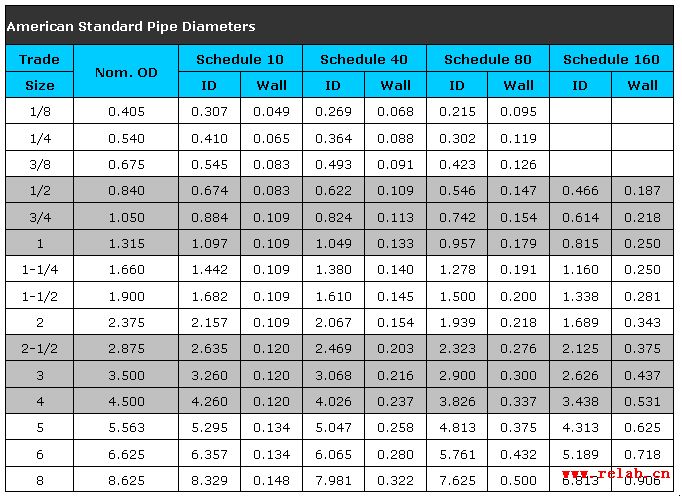
RELAB Spraying & Purification Technology Ltd.
RELAB is an acknowledged leading Manufacturer and Exporter.
Spray Nozzle, Flat Fan, Full Cone, Hollow Cone, Spiral Nozzle, Air Atomizing, Mist Nozzle, Fog Nozzle
Brass, Stainless Steel, SUS303, 304SS, 316SS, 316LSS, PP, PVC, POM, PVDF, PTFE, Ceramic, Ruby, SiSiC
NPT VS. BSP Pipe
NPT threads are common in the United States;BSP threads are widely used in many other countries,BSPT -British Standard Pipe Taper,BSPP -British Standard Pipe Parallel,NPT -National Pipe Taper,NPS -National Pipe Straight
Contents:
NPT vs BSP Pipe
NPT threads are common in the United States; BSP threads are widely used in many other countries.
* BSPT -British Standard Pipe Taper
* BSPP -British Standard Pipe Parallel
* NPT -National Pipe Taper
* NPS -National Pipe Straight
While the actual specified outside diameters of American National Pipe differ slightly from those of British Standard Pipe, either thread may reliably be cut onto a pipe of its respective trade size. BSPT and BSPP threads are analogous to NPT and NPS threads, respectively.
NPT/NPS and BSP threads are not compatible due to the differences in their thread forms, and not just the fact that most diametrical sizes have a different pitch. NPT/NPS threads have a 60?included angle and have flattened peaks and valleys (this is a Sellers thread form); BSP threads have a 55?included angle and have rounded peaks and valleys (this is a Whitworth thread form).
NPT and BSP thread pitches (threads per inch, TPI) are listed below. To determine pitch, use a thread gauge or count the number of threads that fall into a 1" span. Note that, strictly speaking, when we use threads per inch, we are actually specifying the inverse of the pitch, pitch being in units of [length] / [peak to peak].
Metric threads are usually specified in actual pitch, e.g., 1.5mm, 2.0mm, etc. This is the actual length of each thread, peak to peak. Although the term "pitch" is universally used, albeit loosely, to describe threads per inch, the actual pitch of a 1/4BSP fitting is really 1/19 inch, or 0.0526 inches.
British Standard Pipe - BSP
BSP: British Standard Pipe
BSP pipe, Like American National pipe (NPT, NPSM), is designated by trade size, rather than actual diameter, which is approximately equal to the thread's Major Diameter in the table below.
There are two types of BSP threads:
* BSPT: British Standard Pipe Taper -also known as R threads
* BSPP: British Standard Pipe Parallel -also known as G threads
Both styles have the same thread angle, shape, and pitch (threads per inch). However, BSPT threads are tapered and BSPP threads are straight (parallel). BSP threads have a 55?included angle and have rounded peaks and valleys (this is a Whitworth thread form).
Here are the actual thread dimension data for BSPP and BSPT threads. The major diameter is a bit larger smaller than the actual OD of the pipe, and the minor diameter should be very close to what you would measure inside the female threaded end of a fitting. Note that the Gage Length dimension pertains only to the BSPT (tapered) thread.

American National Pipe - NPT/NPS
American National pipe (NPT, NPS), Like British Standard Pipe (BSP), is designated by trade size, rather than actual diameter, as shown in the table below.
There are two basic types of National pipe threads:
* NPT: National Pipe Taper
* NPS: National Pipe Straight
NPT threads are also sometimes referred to as:
* MIP (Male Iron Pipe)
* FIP (Female Iron Pipe)
* IPT (Iron Pipe Thread)
* FPT (Female Pipe Thread)
* MPT (Male Pipe Thread)
Note that these references are somewhat casual, and might possibly be used in reference to NPS instead of NPT.
Both NPT and NPS have the same thread angle, shape, and pitch (threads per inch). However, NPT threads are tapered and NPS threads are straight (parallel). Both threads have a 60?included angle and have flat peaks and valleys (this is a Sellers thread form).
If you've worked with pipe much at all, you've probably noticed that the size of the pipe isn't really what size the pipe is. Unlike tubing, which is generally specified by its OD, or hose, which is generally specified by its ID, pipe is specified by something else... its Trade Size. So when you say "3/4 pipe," you're actually saying "pipe whose OD is a little more than an inch, and whose ID is about 53/64." -that is, if you are talking about schedule 40 pipe, which is generally what is used for most plumbing applications.
Pipe dimensions are specified by trade size and schedule, according to the following table. Note that while British Standard Pipe dimensions are similar, they are not equivalent to the American Standard Pipe Sizes. See NPT vs. BSP Pipe for thread comparisons.
The article quote from www.PipeandHose.com
- Contact Us
- Environmental Policy
- Operation Principle
- Quality Certification
- Spray Nozzles
- Fog Nozzle
- Technical Details
- Site Map
- Company Address: Changan town Dongguan City Guangdong Province of China
- Tel: 86(769)-81872789 85076919 Fax: 86(769)-85079909 E-mail: info@relab.cn
- Website http://www.relab.cn Certificate ID: ICP-07070062